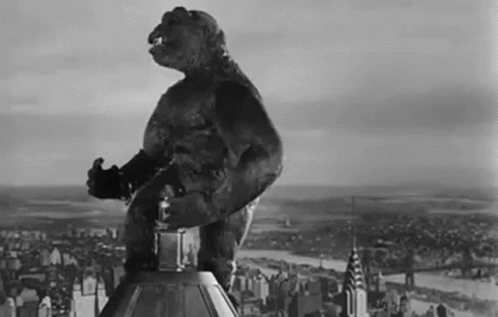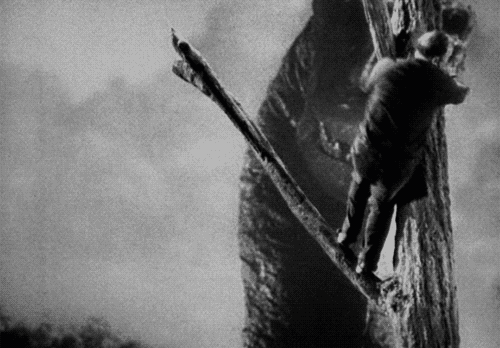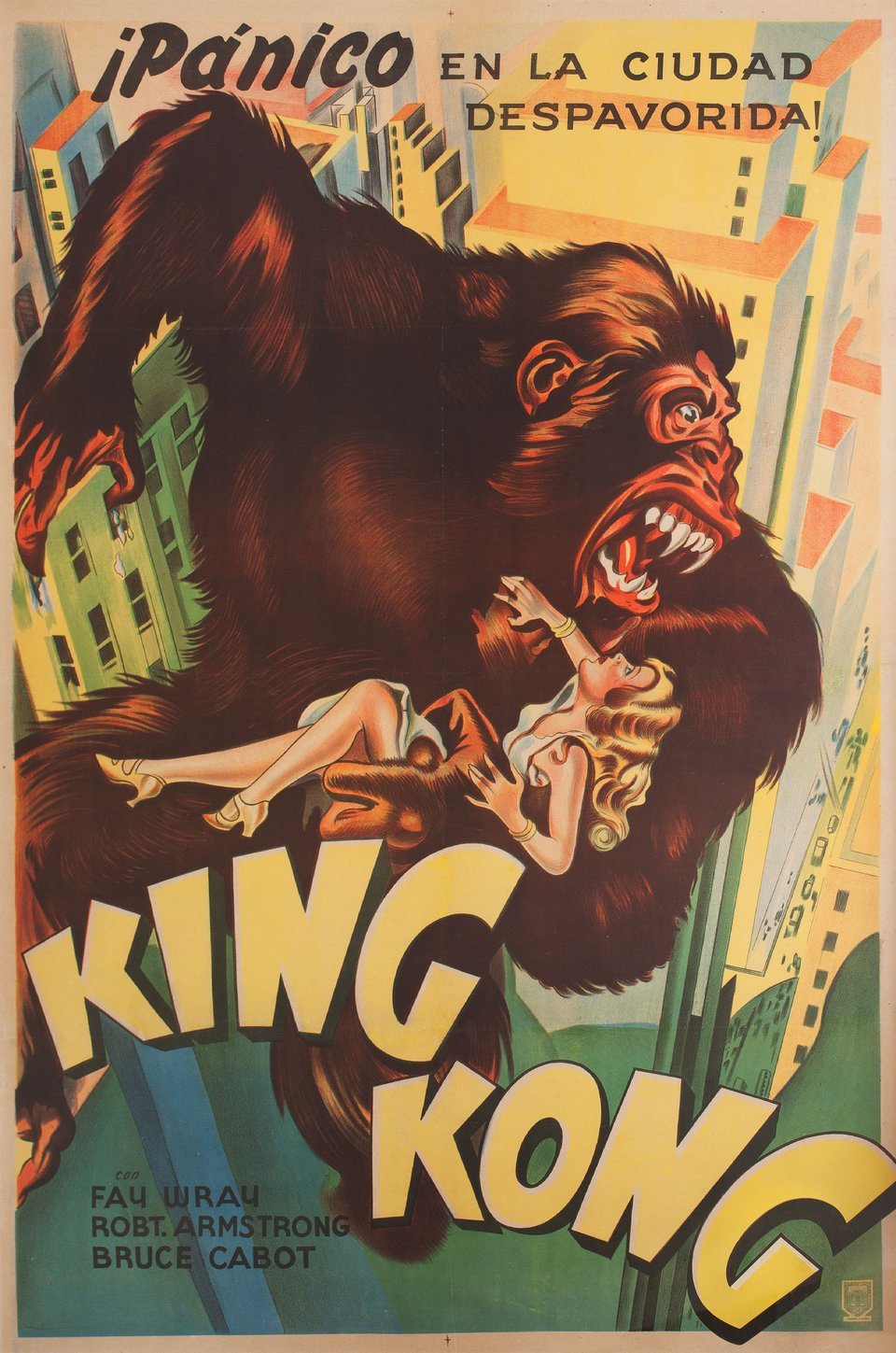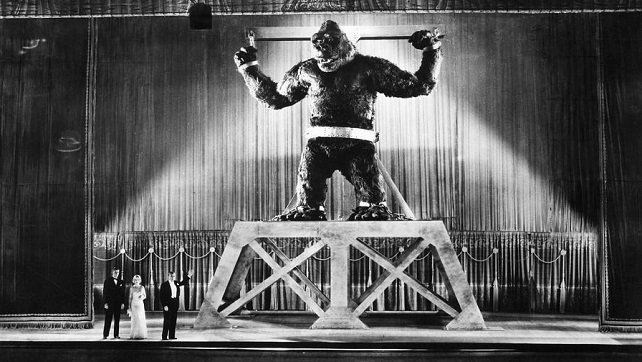1933's King Kong is a Miracle of Storytelling and Technology
King Kong was an extraordinary, zeitgeist-capturing success upon its release in 1933 before being successfully re-released in 1938, 1942, 1946, 1952 and 1956.
Before the rise of television, King Kong could be re-released over and over again because, on a technical and storytelling level it was still unsurpassed decades after its release.
Nearly ninety years later King Kong still reigns supreme as a towering, unbeatable creative achievement. We’ve never done better than King Kong. We never will.
The original tale of a simian New York tourist run amok benefitted from being made before the dreary dictates of the Hays Code ruined everyone’s fun and imposed a restrictive, hypocritical moralism and propriety on an industry with no use for either.
The Production Code would tame the movie business’ rampaging id and unrelenting horniness but not until after King Kong captured the public’s imagination with a provocation that is notable in no small part due to its brutality.
In a jaded realm the violence in King Kong retains its power to not just surprise but shock due to its pummeling intensity but also its artistry. Stop-motion animation reaches an apex here that it’s never topped. The filmmakers created a world unlike any other audiences had seen before, then populated it with some of the most incredible creatures ever to grace the big screen. It’s a testament to the film’s world-building that pretty much every dinosaur encountered on Skull Island is as gorgeously conceived and beautifully realized as King Kong and King Kong is rightly considered one of the greatest icons in film history.
King Kong took full advantage of freedoms that would not exist for much longer to create a uniquely brutal cinematic experience full of sex, violence, bombs and death. It’s also eternally contemporary in its attitude. King Kong is smart-ass and cynical about about everything: movies, show-business, Hollywood producers, colonialism, sex, money and capitalism.
The only area where King Kong was not ahead of its time, unfortunately but unsurprisingly, is in its attitude towards race. In that respect it is very much a product of its time.
King Kong depicts all of humanity in a very negative light. Filmmaker Carl Denham (Robert Armstrong) is the film’s protagonist as well as its true villain. King Kong is just an animal acting on instinct. The movie producer, on the other hand, is more than willing to sacrifice the lives of many for the sake of stealing a boffo box-office attraction from his home.
Victor Wong is regrettably cast as comic relief cook Charlie and it’s hard to deny troubling racial overtones in a movie produced in the early 1930s where a superstitious black tribe worships a giant gorilla as a God and abducts a beautiful white woman to pacify him as a sacrifice.
But if King Kong unfortunately reflects the racial attitudes of its time it’s appropriately harsh on ugly Americans who discover a living miracle in Kong and Skull Island and only want to exploit him for money and turn one of nature’s true marvels into a sorry spectacle for New Yorkers to gawk at.
King Kong opens with Carl Denham seeking collaborators for a mysterious creative enterprise that’s a criminal endeavor as well. The king of the jungle pictures needs a leading lady for his next cinematic extravaganza but respectable professionals are reluctant to work with him out of a richly merited suspicion that he’s a sleazy opportunist with little to no regard for human life.
The flashy showman needs a warm body to act in his next film. She doesn’t have to be a talented actress or even an actress, really. She just needs to be attractive and willing to travel great distances and risk death for his sake and the sake of the production.
Carl finds his warm body in Ann Darrow (Faye Wray), a destitute beauty he encounters unsuccessfully attempting to steal an apple from a fruit cart. The heartless pragmatist gets Ann out of a bind and asks her if she’s interested in an acting gig and very long sea voyage.
Ann is nothing if not available so she says yes to Carl’s dodgy proposition and develops a crush on sailor Jack Driscoll (Bruce Cabot). King Kong perplexingly has a male romantic lead whose defining characteristic is his hatred of women.
The film’s hero is a real He-Man Woman Hater type but while he despises the fairer gender in its entirety he makes an exception for Ann on account of she’s pretty and he’s sweet on her.
Jack isn’t just uncultured. He’s a goddamn brute, an unabashed chauvinist. He’s more of a beast than Kong but he’s handsome and confident she falls for him while leaving King Kong in the Friend Zone when he’s literally willing to fight a dinosaur for her.
King Kong creates an overwhelming sense of dread and foreboding on the voyage from New York to Skull Island. We’re leaving the world we know and entering an exhilarating, horrifying world beyond our imagination where seemingly anything is possible and dinosaurs have not only survived but evolved into even more terrifying monsters.
We’re still on planet earth but everything feels unmistakably alien. It’s not our world but a lost world full of wonders and terrors.
The human inhabitants of Skull Island live in fear of Kong, who they treat as an angry god who must be given tribute in the form of sacrifices and “brides.” The tribe is EXTREMELY interested in procuring Ann’s services as a bride of Kong but when rebuffed they simply take her, leading the filmmakers to embark on a rescue mission.
Watching the crew tangle with seriously un-kind dinosaurs inspired in me the same sense of wonder I experienced watching King Kong for the first time as a kid. I am legitimately in awe of King Kong. It consistently accomplishes the impossible.
Any one of the film’s dinosaurs would be pretty much any other fantasy or horror film’s crowning achievement. Here there are a whole bunch of dinosaurs, each realized down to a molecular level, and they’re essentially just background players, secondary monsters to get through before you get to King Kong, the main event.
King Kong is terrifying and merciless. There’s a wonderfully, characteristically bleak moment that was cut from post-Hays Code versions where Kong is running amok in Manhattan and grabs a woman he mistakes for Ann, sees that she’s nowhere near as attractive and haphazardly flings her to the pavement below and an ugly, messy death.
But Kong is also emotionally complex, sympathetic, expressive, tragic and achingly sad. He’s at once strangely human and all animal. It’s a testament to the film’s richness that a giant gorilla’s crush on a pretty thief has more emotional weight than the central relationship in even top-tier romantic dramas.
Carl isn’t content to have narrowly avoided death and dismemberment. Despite all the devastation he has witnessed, he wants to bring Kong back to the United States so that he can coldly exploit him as a theatrical attraction.
Kong is a great and terrifying God in his world but all it takes is a single gas bomb to knock him unconscious and ready for a sea voyage to New York. Man’s weapons are pathetic and cowardly compared to the natural might of Kong. Yet they do the trick and work their evil magic on the Eighth Wonder of the World all the same.
King Kong is so synonymous with New York and the Empire State Building that it’s easy to forget that the climax where Kong rums amok and terrorizes Manhattan only takes up its final twenty minutes.
The filmmakers move the action from Skull Island to Broadway in a single miraculous cut that brings us instantly into the Manhattan high life, where a visitor by the name of Kong is about to make his grand debut before a packed audience.
It’s a uniquely misconceived gig that’s doomed to failure. Sure enough, Kong goes mad in the inhuman glare of photographer’s cameras. He breaks free and terrorizes Manhattan and its residents.
Every moment, shot and beat of the New York scenes in King Kong has been parodied and ripped off and paid reverent tribute to and mashed up into other contexts yet it retains its freshness and novelty.
That’s true of the film as a whole. It’s never gotten old. It never will get old. It will forever be new and brilliant and innovative, a goddamn gift to the world of film about some uniquely unethical filmmakers and one VERY big problem.
Buy The Weird A-Coloring to Al: Cynical Movie Cash-In Extended Edition at https://www.nathanrabin.com/shop, signed, for just 12 dollars, shipping and handling included OR twenty seven dollars for three signed copies AND a free pack of colored pencils, shipping and taxes included
Enjoy reading about movies about movies such as King Kong? Pre-order The Fractured Mirror, the Happy Place’s next book, a 600 page magnum opus about American films about American films, illustrated by the great Felipe Sobreiro over at https://the-fractured-mirror.backerkit.com/hosted_preorders
The Joy of Trash, the Happy Place’s first non-"Weird Al” Yankovic-themed book is out! And it’s only 16.50, shipping, handling and taxes included, 30 bucks for two books, domestic only!
Buy The Joy of Trash, The Weird Accordion to Al and the The Weird Accordion to Al in both paperback and hardcover and The Weird A-Coloring to Al and The Weird A-Coloring to Al: Colored-In Special Edition signed from me personally (recommended) over at https://www.nathanrabin.com/shop
Or you can buy The Joy of Trash here and The Weird A-Coloring to Al here and The Weird Accordion to Al here
Help ensure a future for the Happy Place during an uncertain era AND get sweet merch by pledging to the site’s Patreon account at https://www.patreon.com/nathanrabinshappyplace We just added a bunch of new tiers and merchandise AND a second daily blog just for patrons!
Alternately you can buy The Weird Accordion to Al, signed, for just 19.50, tax and shipping included, at the https://www.nathanrabin.com/shop or for more, unsigned, from Amazon here.
I make my living exclusively through book sales and Patreon so please support independent media and one man’s dream and kick in a shekel or two!










